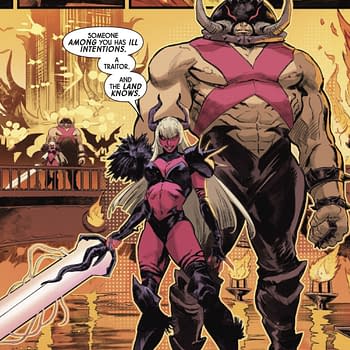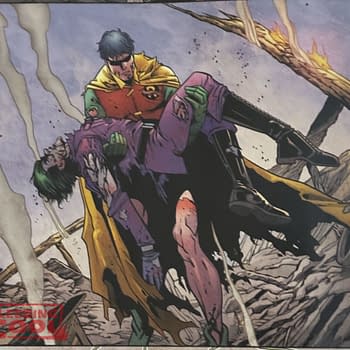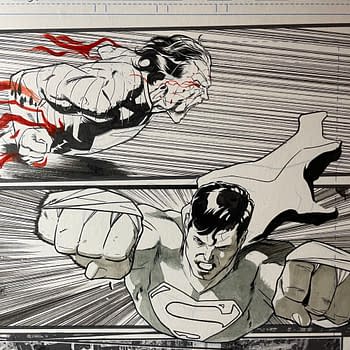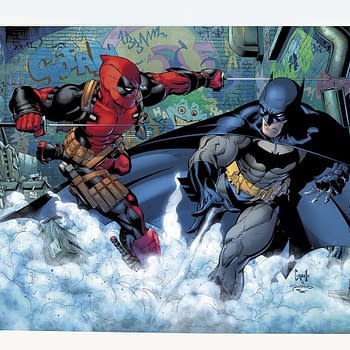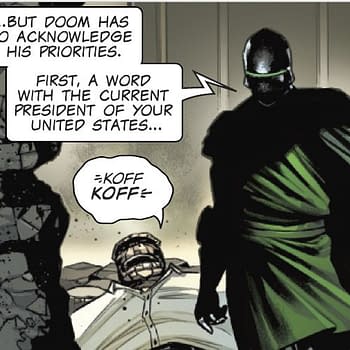Posted in: Comics | Tagged: Comics, devolution, dynamite, entertainment, Jonathan Wayshak, rick remender
Rick Remender Talks About Devolving The World
Rick Remender's newest series is coming out from Dynamite Entertainment. It's called Devolution and it's about: "Every living creature on Earth has been devolved – the evolutionary clock turned back, reverting all life to odd mutations and prehistoric incarnations. The cities of man are little more than bloody territories ruthlessly dominated by tribal Neanderthals ruling from the backs of mammoths, packs of saber-toothed tigers, and giant man-eating insects." Joining Remender on this project are artist Jonathan Wayshak and colorist Jordan Boyd. Roger Ash chatted with Remender about the new series.
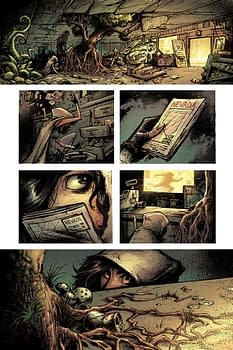
Rick Remender: This is a book I cooked up in 2005 and wrote the outline for in 2006. I pitched it to Nick (Barrucci, Dynamite CEO/Publisher) in 2006, I believe. I know for a fact that I was listening to Devo, one of my favorite bands. The general idea behind the band and a lot of what they talk about is the devolution of man in modern society. Their version of it is obviously more of a social commentary. I just started thinking about how cool it would be to live in a world where a lot of people had been reverse-engineered into Neanderthals. Just make-believe science, chickens become Velociraptors and spiders become giant. Especially back then, I was looking for ideas that could give me a playground that smelled like an old EC comic book. I think that's part of where it came from as well. At that point in time, there was no new Road Warrior or Jurassic Park movie to look forward to, and I liked the idea of kind of mixing those two things; a high velocity story that has sort of a Road Warrior feel in a world that was like Jurassic Park. That was the catalyst. I didn't have an artist lined up immediately, but somebody's gonna want to draw that.
RA: What's taken so long for it to be published?
RR: A lot of varying factors; contract negotiations being a big one.
Scheduling. Once contract things were worked out, schedules would get screwed up. Paul Renaud had, at one point, signed on to draw it and then, due to some of my own scheduling problems, he couldn't. I was very fortunate to get to work with him at Marvel. During that time, that was one of the things that was eating up most of my schedule. It was a lot of varying factors. Once I got back around to it, and Paul had already moved on; I had to line up a new artist. I got Jon Wayshak, who is one of my favorite artists. He came up with Jerome Opena and those two guys were two of my heroes, going back to my time in the Bay Area. We brought in Jordan Boyd to realize it and give it his color love. It was just a series of road blocks.
At one point, it just kind of drifted. Once Jon and Jordan signed on, it was easier to realize it. It's very odd seeing a script I wrote a decade ago brought to life. It's very interesting, because I see a lot of my old writing habits and I haven't seen them in a while. Obviously I'm going to be punching up the dialog a bit and revising bits, but it's mostly the same thing I wrote ten years ago.
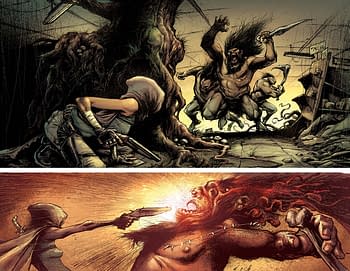
RR: It's a dream. Jon is a world class illustrator. In his world, he's a huge name. He dabbles in comics once in a while because he loves them. He doesn't live in comics. For me it was a big get to pull him in. He's quite possibly one of the best illustrators in the world, but definitely one of the best in terms of his rendering and his imagination. I knew that getting Jon in to do some of the crazy creatures and strange worlds and things that I wanted was going to be a treat. And it really has been. As well as our main antagonist, the Nazi redneck Gill. He's one of the greatest artists when it comes to capturing insanity and depravity.
RA: Aside from Gill, who are some of the major characters that readers will meet in the book?
RR: It's an ensemble cast so there's a large cast. One of the POV characters is Raja. She is someone who has information on a laboratory that was developing a revolution agent that could ostensibly reverse the state of the world and re-evolve things. She's on a pilgrimage to make it to this laboratory in Silicon Valley to get her hands on this, when she runs afoul of some of the marines that were inoculated against the devolution agent when it was used in warfare. They are still Sapien, and they are still human. They are barbaric. Her story changes course once she runs into these people. From there the action begins.
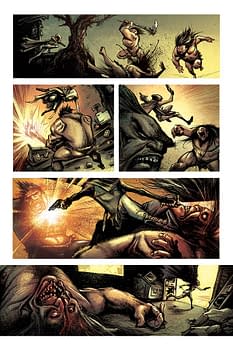
RR: No. This is 100% nonsense pulp and that's how I like it. There are the standards, like birds are remnants of the dinosaurs. I'm like, "OK.
Chickens become Velociraptors!" Is there an actual chain that links those two? There probably isn't. Humans aren't probably directly linked to Neanderthals, but you have fun with science a little bit. In that sense, I'm defining it as they are reverse evolved but they're also reverse mutated so you get things that existed a couple million years ago and sometimes you get things that never existed. That way I can create whatever I want.
RA: How much world building did you do for the series?
RR: A good bit. It's only five issues so it doesn't demand the most.
In terms of the cast, in terms of where they're headed, and in terms of the end goal I cooked all that up in the initial outline and it's still the same as it was. Before I tear those scripts out and send them to Jon I go over them and change bits and pieces but then I realize that changing things that I wrote ten years ago seems like [George] Lucas. That was an idea I had ten years ago that I might not write right now. There's a lot of gratuitous violence and sex and not necessarily the way I would handle it now, but I left it there because that was the intent I had ten years ago. It's fun to see this last thing that I cooked up as part of a slew of books like Strange Girl and Fear Agent and Last Days of American Crime and End League. It's fun to see the last one of those that I developed get made so I'm leaving it, for the most part, how it was.
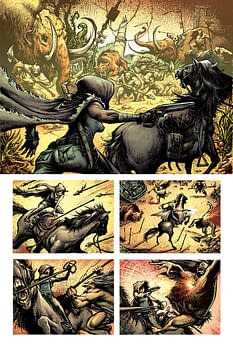
RR: One of the big ones is how I condense things now. If you look at the first six issues of Black Science, for example, that was an outline I started picking at in 2012. The first six issues was 12 issues of outline. I went through and gutted everything that wasn't mandatory and I shrunk it down as much as I could. What you get is a shotgun blast in six issues. I've always been a compressed storyteller, but I think I got even more compressed as time went on. There are some things here that I'm thinking about reconsidering. Issue #3 is really one big chase sequence with all these crazy creatures and it's very much a chunk of Road Warrior story where they're being chased through this world. It's kinda wonderful. It's nice to see an illustrator put down that motion and that action on paper. There's a lot of technique stuff and craft stuff that I've picked up along the way.
When I looked back at the script, I tweaked a few things here and there to smooth it out. At the same time, there was something about the purity of the intention of the idea in the first place and just letting it be what I wrote a decade ago and seeing it come to life.
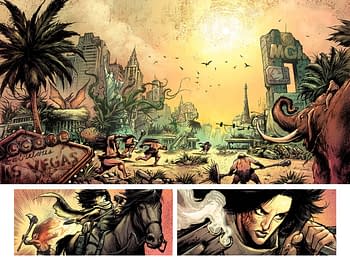
RR: There's a little social commentary peppered in there but it's not too heavy handed. It would be a bit flat if it weren't in there. The greater example of our own devolution. More than that, it's just a fun, high octane comic book. I can't speak to ten years ago Rick Remender's writing but I can say that Jon and Jordan have certainly delivered a lot of beautiful pages.
For more on Devolution #1, click here.









